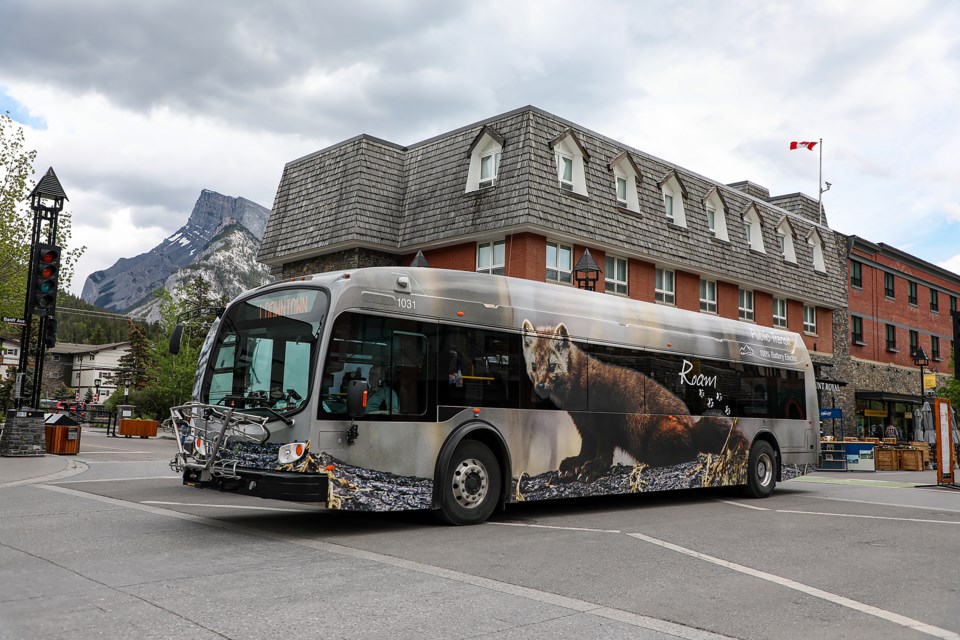CANMORE – A service review for Roam public transit in Canmore will begin this fall to see if potential changes to routes and stops are needed and to outline the potential growth of the free service.
At its Sept. 14 meeting, the Bow Valley Regional Transit Services Commission (BVRTSC) board approved the $35,000 review, which is to be completed by Dillon Consulting, and to return to the board towards the end of 2023.
“We’ll be looking at our existing service and seeing what areas could use some improvements,” said Martin Bean, CAO of BVRTSC. “We’re also looking at future expansion and when we do choose to add routes, where the best destinations are, the best routing, what kind of frequency we’d like to get to or need to get to, to meet the goals of Canmore in getting vehicles out the door.”
Bean said the service review will look at the next five to 10 years of bus transit in Canmore, which will include looking at how the town is growing to factor in how transit will fit with new development.
Roam doesn’t have specific ridership projections for Canmore in the next five to 10 years, especially as it continues to recover from the COVID-19 pandemic that decimated ridership numbers, but Bean said the early trends in 2022 have seen increases.
However, he said as service increases, ridership has continued to grow.
From the end of August 2019 to August 2022, Canmore ridership has seen an 18 per cent increase from 89,520 to 105,400.
“What we’ve seen so far, and part of the study will work through those projections, is if you increase the frequency, make it affordable such as the fare free transit in Canmore, then ridership will increase.”
Dillon Consulting did the Banff service review in 2018 and assisted with the planning for the Lake Louise routes.
The $35,000 for the service review will come from the commission’s Canmore operating reserves, which sat at $273,000 prior to the review being approved.
In 2024, Canmore will be getting a long-awaited and much discussed route that will connect Quarry Lake, the Canmore Nordic Centre, Grassi Lakes and the Visitor Information Centre with the town. The route would have 18 new stops and utilize 12 existing stops and run for 60 minutes from start to finish.
The province has been completing construction this year at Grassi Lakes day-use area to increase parking and have room for public transit.
Alberta Environment and Parks contributed $944,000 for the bus purchase for the three-year pilot, which is coming from Kananaskis Country Pass revenue. An additional $670,000 came from the province and $780,000 from GreenTRIP funding. Town council approved $275,000 in 2021 – expected to be covered by paid parking revenues – and roughly $150,000 in annual operating costs for Roam.
Tanya Foubert, one of Canmore’s two representatives on the commission, said the route could potentially begin in 2023, but that it was vital to do the logistical work before buses hit the road for the new route.
“It’s important to do the work first before moving forward with the new route,” she said. “There is some consideration of the route starting in 2023, but as a commission we don’t want to put more on the plate than we can handle. Given what we’re experiencing with driver shortage, it’s better to invest in planning for 2024.”
Roam has already started recruiting for drivers as opposed to in January and February in past years.
Roam transit will also undergo a fare review for 2023 that is expected to be completed by the end of that year.
Bean said one aspect will look to consolidate information for drivers since hotel passes, token transit, ticket vending and reservations are all done differently and give drivers extra work when passengers are boarding.
He said the work will be done internally by the new systems analyst position that is to be created in the new draft budget, which was approved by the board. The draft budget is up for a 30-day public review period before the final vote on Oct. 17.
Roam is taking part in multiple planning studies for both electric and hydrogen-powered buses. The local transit service is working with Equicharge to complete its first electrification planning study to help guide Roam in future planning for both vehicles and facilities.
It is also part of a hydrogen project by Hydrogen Technology and Energy Corporation (HTEC) with other transit services to see the zero emission and busing possibilities, as well as another being done by Fortis and Canadian Urban Transit Research and Innovation Consortium on electric buses.
Roam has been one of the leaders in public transit in Canada in utilizing electric buses. It and Parks Canada signed a five-year $12.9 million agreement to purchase three new buses, cover operating costs and expand services to reduce car use and road emissions in Banff National Park.
Two new electric buses were approved earlier in the year by the commission to replace two hybrid buses, with the bulk of the funding coming from the province’s GreenTRIP program.
By 2023, it’s expected 10 of Roam’s 32 buses will be electric.
The Canmore service review will be one of the key guiding documents for years to come as the valley continues to emphasize public transit.
“Even if you don’t change anything, it’s good to reaffirm what you’re doing and see if there are changes that could make it better,” Bean said.




